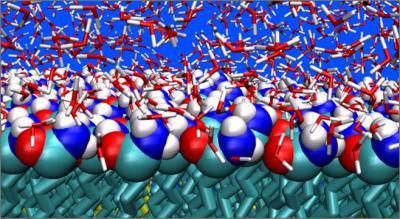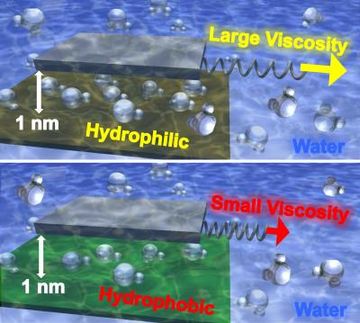Liquid or solid? Charged nanoparticles in lipid membrane decide
Advertisement
Like water and ice cubes mixed in a glass, a group of organic compounds called lipids can coexist as liquid and solid in membranes. This patchiness in phospholipid membranes is fundamental to their use as biomolecules and biosensors. Using charged nanoparticles, researchers at the University of Illinois have found a new way to stimulate patchiness in phospholipid membranes.
"We are seeing a previously unsuspected responsiveness in phospholipid membranes," said Steve Granick, a Founder Professor of Engineering at the U. of I. "What we thought was possible only with the specificity of certain proteins, we now see can happen with simple, charged nanoparticles."
In earlier work, Granick and graduate student Liangfang Zhang found a way to stabilize sensitive lipid membranes by attaching charged nanoparticles to the membrane surface. Now, Granick, Zhang, graduate research assistant Bo Wang and research scientist Sung Chul Bae show that a phospholipid membrane can coexist in two phases – solid and liquid – according to what binds to it. This inherent patchiness presents an additional mechanism for changing the stiffness of phospholipid membranes.
Using fluorescence and calorimetry methods, the researchers studied interactions between charged nanoparticles and membranes formed from single-component lipids. Because the membrane was composed of one sole lipid type, the traditional explanation for spatial patchiness – an uneven distribution of different lipids – was eliminated.
While a variety of nanoparticles was used, the most common type was polystyrene spheres about 20 nanometers in diameter. Where the nanoparticles attached to the membrane, the membrane responded by changing phase.
"The electric charge acted as a switch," Granick said. "Nanoparticles with a negative charge switched membranes from liquid to solid. Nanoparticles with a positive charge switched the membranes from solid to liquid."
Phase changes occurred in patches of membranes where phospholipid molecules swiveled after binding to charged nanoparticles. This binding-induced behavior, where the same lipid can coexist in two different phases, offers a new mechanism for modulating stiffness in membranes.
In future work, the researchers plan to study the effects of smaller, charged nanoparticles; the effects of charged nanoparticles on living cells; and novel ways to stabilize lipid membranes for targeted drug delivery.
"These experiments are helping us better understand both the structure of phospholipid membranes and the potential biological effects of exposure to nanoparticles found in our normal, everyday environment," Granick said.
Original publication: Proceedings of the National Academy of Sciences 2008.
Other news from the department science
These products might interest you
Most read news
More news from our other portals
See the theme worlds for related content
Topic world Sensor technology
Sensor technology has revolutionized the chemical industry by providing accurate, timely and reliable data across a wide range of processes. From monitoring critical parameters in production lines to early detection of potential malfunctions or hazards, sensors are the silent sentinels that ensure quality, efficiency and safety.

Topic world Sensor technology
Sensor technology has revolutionized the chemical industry by providing accurate, timely and reliable data across a wide range of processes. From monitoring critical parameters in production lines to early detection of potential malfunctions or hazards, sensors are the silent sentinels that ensure quality, efficiency and safety.



































































